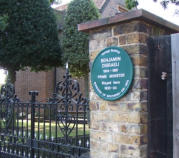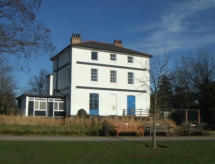1820
c1820. Prospect House is built, the home of Elizabeth Heygate, later the birth place of George Warwick Deeping.
Sheep
rustlers
are
hanged.
The
offence
of
sheep
stealing
attracted
the
death
penalty.
In
1820
the
last
case
to
have
this
imposed
happened
in
Southend.
Thomas
Fairhead
(23)
a
Southend
butcher,
Henry
Gilliott
(23)
a
shepherd
from
Temple
Farm
and
Henry
Jay
(21)
a
butcher
from
Great
Wakering,
were
convicted
of
stealing
a
sheep
from
Temple
Farm,
Prittlewell.
Fairhead
and
Gilliott
were
hanged and Jay was transported for life.
1823
New
Landlord
at
the
Hope.
George
Culham
is
formally
registered
as
the
landlord
for
the
Hope
Hotel
on
Marine
Parade
in
1823.
The
Hope
can
possibly
be
counted
as
the
oldest
and
still
current
hostelries
in the town.
1824
Major-General
William
Goodday
Strutt
(1762
-
1848)
moves
to
Marine
Parade.
The
town
saw
the
arrival
of
an
influential
man
to
a
young
Southend,
Moving
into
a
prominent
building
along
Marine
Parade,
Rayleigh
House,
Major
General
William
Goodday
Strutt
became
a
leading
figure
in
local
affairs.
He
was
very
influential
in
the
building
of
the
first
pier
and
in
the
building
of
Southend's
parish church St John's.
Kents,
a
partly
moated
house
on
the
main
Shoebury
road
(A13),
350
yards
north
of
Danger
Bridge,
was
built
on
the
site
of
a
16th
Century mansion. Half the moat was then filled in.
1826
A whale, 46 feet in length was found on Foulness sands and towed by barge to Leigh.
1829
May.
The
Act
(Geo.IV.Cap.xiix)
authorising
the
construction
of
the
first
Pier,
received
Royal
Assent.
Alderman
Sir
William
Heygate,
Bart,
Lord
Mayor
of
London
in
1822-23
who
resided
at
Porters
in
Southend
was
the
chief
promoter,
and
was
instrumental
in
securing
the
erection
of
the
Pier.
A
great
celebration
ensued
as
crowds
gathered
outside
Royal
Terrace
when
Sir
William
emerged
waving
handkerchiefs
to
announce
Southend's
wooden
pier
had
received
Royal
Assent,
the
pier
was
finally
going
to
be
built.
The
crowds cheered and the band played.
July.
First
stone
of
embankment
of
the
Southend
Pier
laid
by
the
Lord
Mayor
of
London,
Alderman
Sir
William
Thompson, MP, as Conservator of the Thames.
Crowstone
Septennial
visit,
Once
every
seven
years
the
Crow
stone
was
visited
by
the
Lord
Mayor
of
London.
it
was
custom
to
'bump'
the
Mayor
after
which
he
presented
the
watermen
two
sovereigns.
The
children
were
entertained by scrambles in the water for money.
1830
Chalkwell
Hall
was
built.
This
building
at
the
time
considered
to
have
no
historical
or
architectural
significance
was
erected
in
1830.
Sitting
in
the
centre
of
Chalkwell
Park
and
was
the
home
to
the
art
group
Metal,
who
with
the
help
of
local
authority
and
Art
Council
funding
turned
the
building
into
a
modern
art
house
while
looking
after
the
historical
aspects
of
this
listed
building.
The
origins
of
this
property
have
shifted
around
this
park
area,
nearby
the
original
house
was
thought
to
have
a
moat
but
fell
into
disrepair.
Replaced
by
another
house
built
during
the
reign
of
Henry
VIII,
this
fronted
onto
the
estuary
and
was
closer
to
Leigh,
it
was
finally
demolished
in
1832.
To
the
east
of
this
building
a
mound
was
identified
as
maybe
having
some
significant
finds
beneath
but
when
exploratory
work
was
done
only
a
few
coins
a
chain
and
some
cloth
were
found.
The
current
property
has
served
as
a
residence
as
well
as
hosting
a
small
zoo
during
the
post
war
period,
even
today peacocks are in residence to the rear.
June.
The
first
section
of
the
wooden
pier,
which
did
not
exceed
1,500
feet
in
length
was
opened.
Until
that
time
passengers
who
wished
to
disembark
from
the
steamboats
from
London
had
to
be
brought
to
the
shore
in
small
boats and then carried to dry land by watermen.
1831
The
Heygate
Baronetcy
of
Southend
in
the
County
of
Essex,
is
a
title
in
the
Baronetage
of
the
United
Kingdom.
It
was
created
on
30th
September
for
William
Heygate,
Lord
Mayor
of
London
from
1822
to
1823
and
Member
of
Parliament
for
Sudbury
from
1818
to
1826.
1832
St
John's
is
born
on
27th
September.
Dr
Blomfeld
Bishop
of
London
presided
at
a
meeting
convened
in
the
Royal
Hotel
where
it
was
agreed
a
Chapel
of
Ease
was
required
for
Upper
and
Lower
Southend.
A
committee
was
formed
to
see
it
into
action.
Subscriptions
were promised of £700. This meeting would lead to the building of St John the Baptist Church.
1833
Benjamin
Disraeli
visited
Southend,
and
resided
at
Porters',
Southchurch
Road,
now
the
Civic
House
and
Mayor’s
Parlour.
It
was
here
he
would
write
to
his
sister
on
15th
February,
about
Southend's
kind
climate, he said "You could not have a softer clime or sunnier skies that at abused Southend."
Pier
Tolls.
With
the
extension
of
the
pier
to
a
length
of
1,500
ft,
it
gave
the
Local
Board
under
the
Act
of
1829, to charge for its use. 1833 saw the erection of a toll gate at the entrance of the pier.
1834
The
town’s
first
loading
pier
was
built
adjoining
the
east
side
of
the
passenger
pier,
made
of
timber
and
stone,
it
extended
234
feet
from the shore. This was demolished when the iron passenger pier was constructed.
1835
Southend
Pier
completed.
Southend's
most
iconic
feature
was
realised
in
1835
when
for
the
first
time
shipping
could
use
the
pier
not
only
for
practical
reasons
but
also
to
enable
the
growing
seaside
resort
to
offer
an
option
to
use
the
waters
of
the
estuary
for
pleasure.
To
signify
its
maritime importance the pier for the first time also appeared on Admiralty charts.
Thanks
to
the
tireless
efforts
of
Leigh
stalwart
Lady
Olivia
Sparrow,
the
poor
children
gained
a
new
school
in
Leigh
Hill.
Herschell's
School
named
after
the
Rev.
Ridley
Herschell,
who
had
been
invited
to
Leigh
to
help
her
raise
the
educational
standards
of
the
children.
The
school
eventually
closed in 1913, but the building is still in existence now as a residential dwelling.
1837
A
magnificent
rectory
starts
to
be
built
in
Leigh
and
the
exterior
has
changed
little
to
this
day.
The
building
now
is
protected
by
the
local
authority
and
used
as
a
branch
library.
This
fine
building
lies
on
the
upper
part
of
the
cliffs
overlooking
Leigh
old
town
on
the
Broadway,
Leigh-on-Sea,
to
the
rear
are
some
public
gardens.
The
building
was
commissioned
by
Robert
Eden
when
he
became
rector
in
1837,
and was completed in 1838.
Thomas
Dowsett
was
born,
later
to
become
a
significant
part
of
Southend's
history
by
being
the
first
person
to
where
the
Town's
Mayoral
Chain.
His
family
later
would
give
to
the
people
of
the
town
Southchurch Hall and Gardens.
Small
town
fun.
Southend
in
the
early
part
of
the
19th
Century
was
relatively
small
compared
to
other
south
coast
seaside
towns.
By
1837
Brighton
had
reached
a
population
of
40,000;
whereas
Margate
from
1831
had
10,000
while
Southend
including
Milton
and
Prittlewell could only muster 2,266 inhabitants.
1838
The third larger Crow stone was erected, the old one erected in 1755 was moved to Priory Park.
It
was
decided
to
commence
building
of
St
John
the
Baptist
Church.
The
footprint
of
this
building
at
this
time
would
have
allowed
clear
views
out
over
the
estuary
and
the
church
would
have been quite a focal point for passing ships.
1839
Prittlewell
gained
a
new
Congregational
Chapel.
No
evidence
of
it
now
as
it
once
stood
almost
opposite St Mary's Church in North Street (now Victoria Avenue).
Timeline

Southend Timeline Southend-on-Sea © 2009 - 2024. All Rights Reserved
1820 - 1839









Watermen
Porters
Crowstone
Hope Hotel
Herschell's Chapel School
St John the Baptist Church
Old Rectory Leigh-on-Sea
Chalkwell Hall


Website Info:

Southend-on-Sea’s No 1 History Website! Documenting The Town & The Townspeople
Now Incorporating The Sea Of Change Website


SOUTHEND CITY
Chalkwell ▪ Eastwood ▪ Leigh-on-Sea ▪ Prittlewell ▪ Shoeburyness ▪ Southchurch ▪ Thorpe Bay ▪ Westcliff-on-Sea
































































